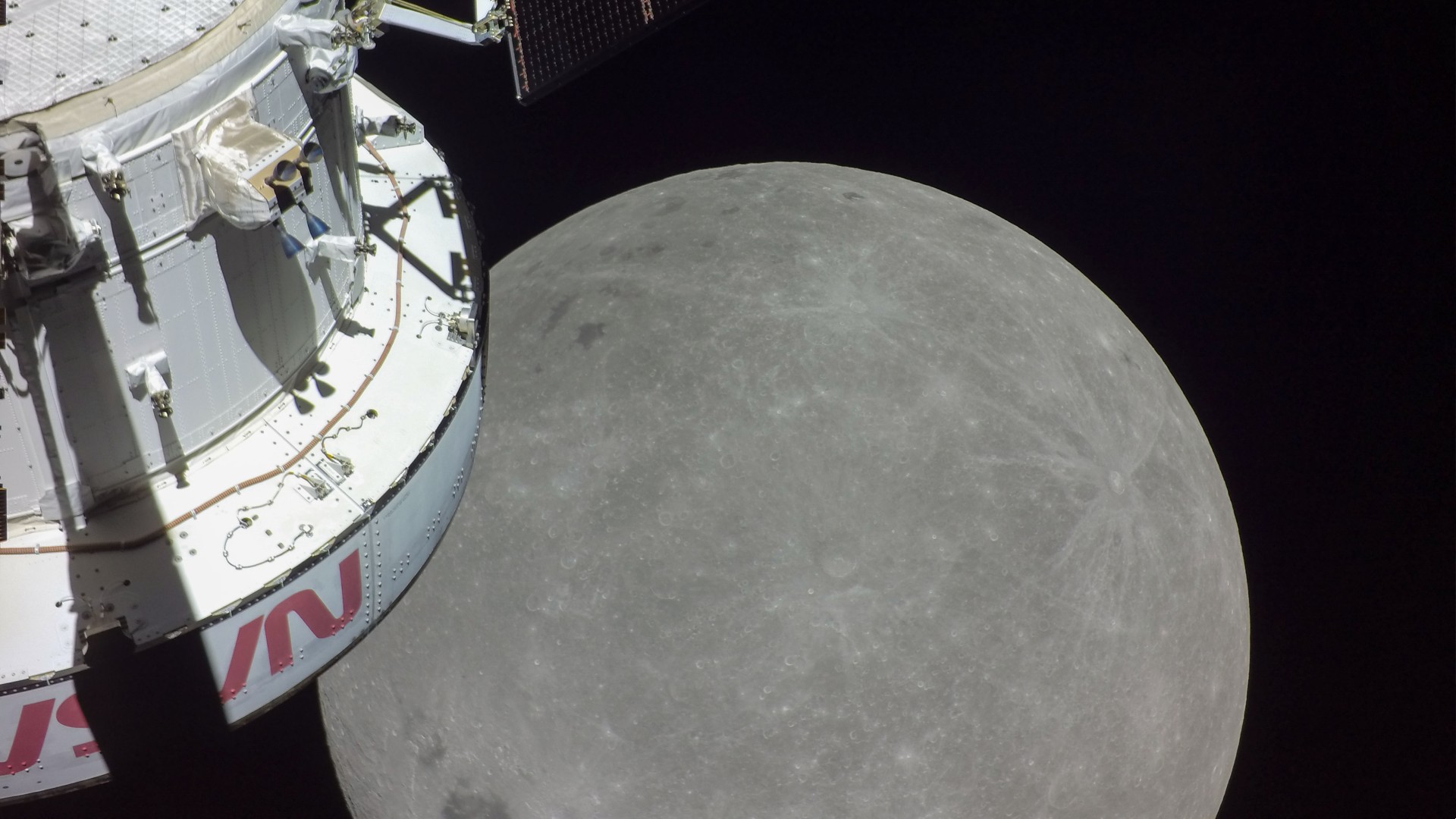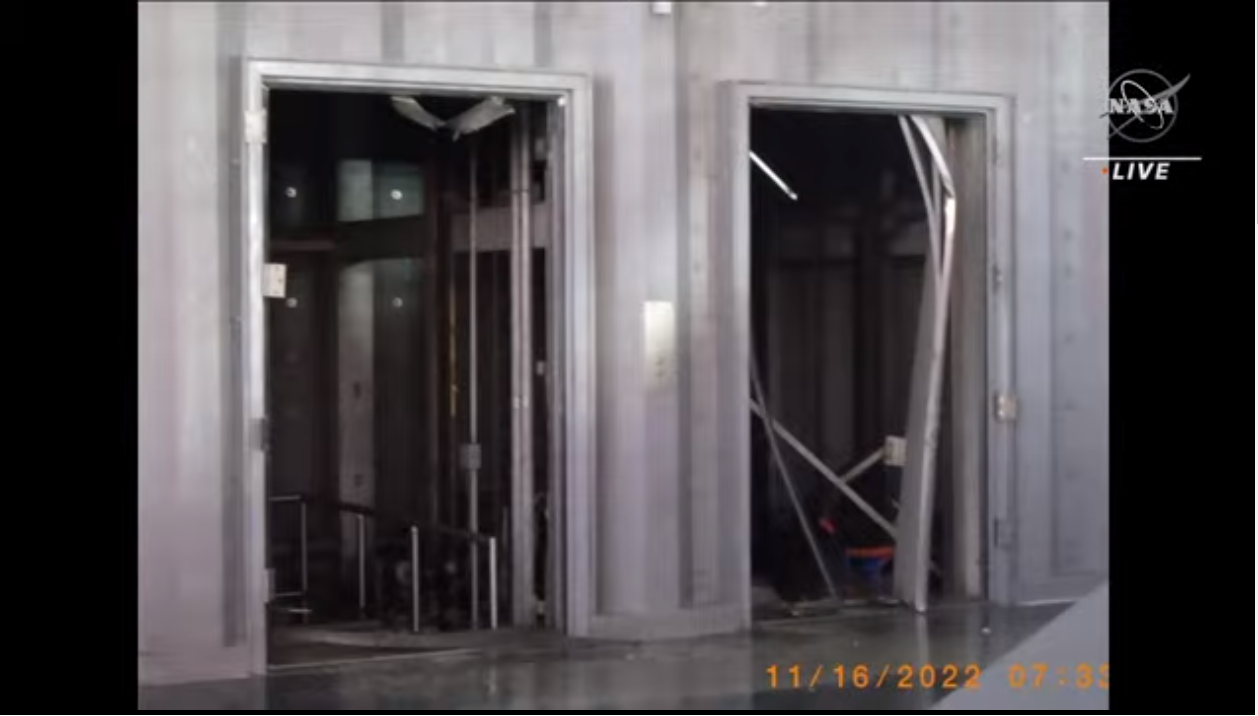NASA 'giddy' over amazing moon views from Artemis 1 Orion spacecraft
"The results were eye-watering."

NASA officials say Artemis 1 mission teams are "giddy" after witnessing how well their Orion spacecraft has been performing so far on its way towards lunar orbit.
Artemis 1 launched at 1:47 a.m. EST (0647 GMT) on Nov. 16, blasting off from Kennedy Space Center in Florida in a spectacular display of the sheer power of NASA's Space Launch System (SLS) rocket. The Orion spacecraft reached Earth orbit shortly after, and then at 87 minutes after launch performed a so-called Trans Lunar Injection burn to send it hurtling towards the moon. On Monday (Nov. 21), Orion performed another burn to send the spacecraft close enough to the lunar surface to leverage the moon's gravity to pull the spacecraft around the moon into a distant retrograde lunar orbit.
After collecting data from that propulsive maneuver, NASA officials held a briefing Monday evening (Nov. 21) to discuss Orion's powered flyby of the moon. Judd Frieling, flight director at NASA's Johnson Space Center, said Orion mission team members are "giddy" with the current performance they are seeing from the spacecraft after the flyby, which saw the spacecraft come within 80 miles of the lunar surface.
Related: NASA's Artemis 1 Orion spacecraft aces close moon flyby in crucial engine burn
Live updates: NASA's Artemis 1 moon mission
Frieling added that flight controllers are so far amazed by the stellar performance they've seen from Orion. "As far as the flight controllers themselves, they're absolutely astounded as well, you know, at these great videos that they're able to get from the Orion spacecraft," Frieling said. "As well as that, you know, they're just happy that all of the hard work and dedication that they've spent for many, many, many years is really paying dividends."
Howard Hu, Orion program manager, said the team has seen "really good performance across the board on all our subsystems and systems and we're certainly really happy with the performance" of the spacecraft so far.
Get the Space.com Newsletter
Breaking space news, the latest updates on rocket launches, skywatching events and more!
"Today was a terrific day," Hu added. "We're coming in every day and it doesn't seem like work. I mean, it is just fabulous. I want to hear the information that's coming from the spacecraft, learning about the spacecraft and being excited about what we're doing. And it's just, it's just been phenomenal. I've got a big smile every day."
The briefing also discussed the launch of the Artemis 1 mission's Space Launch System rocket on Nov. 16. Mike Sarafin, Artemis 1 mission manager at NASA headquarters, said the SLS rocket performed flawlessly during launch. "The results were eye-watering," Sarafin said. "The rocket performed and/or exceeded expectations." Sarafin added that the "kindler, gentler" fueling procedure that was performed for the successful third launch attempt also produced the results mission managers expected, circumventing some of the issues that plagued previous attempts.
Sarafin also discussed the damage that Launch Pad 39B at Kennedy Space Center suffered during the launch. While much of the damage was expected and similar to other launches, the 8.8 million pounds of thrust produced by the SLS vehicle's core stage and two solid rocket boosters literally blew doors in. "The elevator system is not functioning right now," Sarafin said. "We had the world's most powerful rocket and the pressure basically blew the doors off of our elevators."

Sarafin said that a segment of RTV, the insulating caulking around the base of Orion that was damaged by Tropical Storm Nicole, was found in the infield surrounding the rocket. It's unclear whether it was stripped off during launch or was previously ripped away by Nicole. A strip of that caulking damaged by the storm was a source of worry prior to launch, but mission managers determined it would not be a risk.
The Artemis 1 mission sent Orion towards the moon on a 26-day journey that will see the spacecraft come within 80 miles of the lunar surface at its closest pass, and some 40,000 miles away at its farthest. The mission is designed as a flight test of the Space Launch System rocket, Orion spacecraft and associated ground control systems ahead of the Artemis 2 and 3 missions currently planned for 2024 and 2025, respectively.
After swinging far away from the moon, Orion will make its way back to Earth where it will splash down in the Pacific Ocean on Dec. 11.
"I will rest well on Dec. 11 after splashdown and recovery is complete, as well as these gentlemen and their teams," Sarafin said.
Follow Brett on Twitter at @bretttingley. Follow us on Twitter @Spacedotcom or on Facebook.
Join our Space Forums to keep talking space on the latest missions, night sky and more! And if you have a news tip, correction or comment, let us know at: community@space.com.

Brett is curious about emerging aerospace technologies, alternative launch concepts, military space developments and uncrewed aircraft systems. Brett's work has appeared on Scientific American, The War Zone, Popular Science, the History Channel, Science Discovery and more. Brett has English degrees from Clemson University and the University of North Carolina at Charlotte. In his free time, Brett enjoys skywatching throughout the dark skies of the Appalachian mountains.
-
COLGeek Reply
You must be looking at different photos from the ones I see. What exactly are you referring to?Roaming Robert said:Why are all the views of the moon smeared out….. seems a bit odd ..:. -
TheBurg "What's the name of the program manager for Orion?"Reply
"Hu"
"The name of the program manager for Orion"
"Hu"
"Who is the program manager for Orion?"
"Yes"
"Why won't you tell me who the program manager is?"
"I already told you Hu is"
"Who is what"
"The program manager"
"Who?"
"Yes. Hu is."
😡









